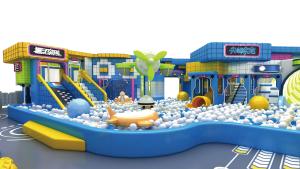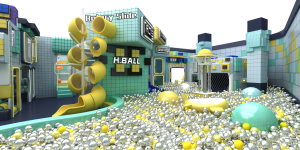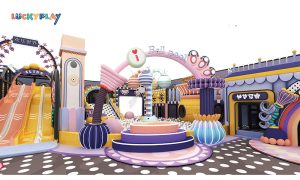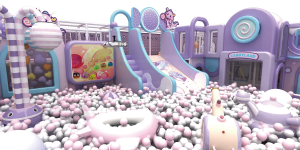Soft play equipment plays a crucial role in child development by providing a safe and stimulating environment for young children to explore, learn, and grow. Designed to be both fun and educational, these play structures offer a range of activities that promote physical, cognitive, and social development. From enhancing motor skills and coordination to encouraging imaginative play and social interaction, soft play equipment supports various aspects of a child’s development.
This article delves into the importance of soft play equipment in fostering healthy growth and development, highlighting its benefits and the positive impact it can have on young minds and bodies.
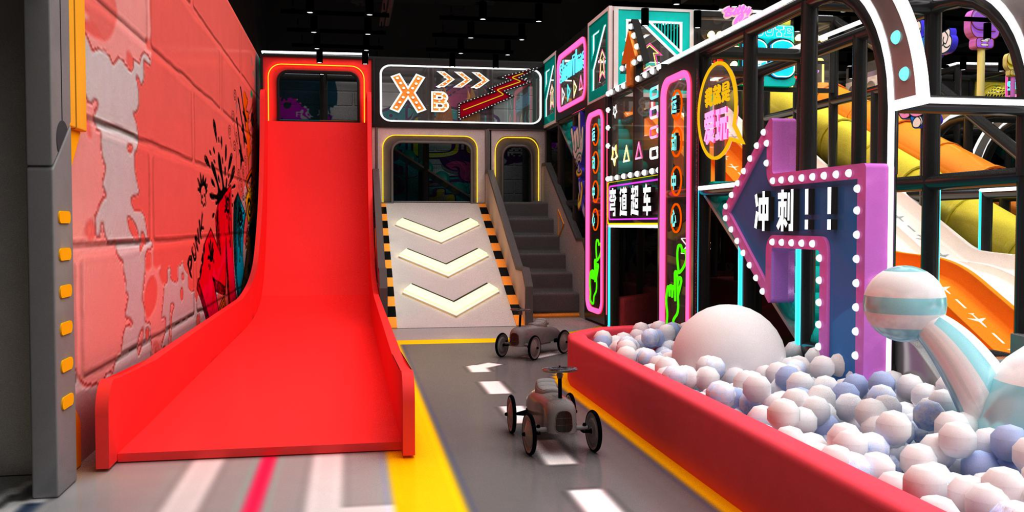
What Is Soft Play Equipment and How Is It Used?
Soft play equipment refers to specially designed play structures made from cushioned, foam-based materials that provide a safe and engaging environment for young children. Unlike traditional playground equipment, soft play structures are designed with rounded edges and soft surfaces to minimize the risk of injury during play. These setups often include a variety of elements such as climbing walls, slides, tunnels, and interactive features, all of which encourage active play and exploration.
Soft play equipment is commonly used in indoor play areas, daycare centers, and early childhood education settings to promote physical activity, coordination, and imaginative play. By offering a controlled and safe space, soft play equipment allows children to develop their motor skills, social interactions, and cognitive abilities in a fun and secure manner.
Why Should You Invest in Soft Play Equipment for Your Facility?
Investing in soft play equipment for your facility provides numerous benefits that enhance both the safety and enjoyment of young children. Soft play equipment creates a secure environment where children can explore and play freely without the risk of serious injury, thanks to its cushioned surfaces and rounded edges.
This safety aspect is crucial for maintaining a welcoming and worry-free space for parents and caregivers. Additionally, soft play equipment supports the development of essential motor skills, coordination, and social interactions, making it a valuable educational tool. By incorporating interactive elements such as climbing structures, slides, and sensory features, you offer children an engaging and stimulating environment that encourages active play and learning.
Moreover, investing in high-quality soft play equipment can increase the attractiveness of your facility, potentially attracting more families and ensuring a higher rate of satisfaction and repeat visits.
How Does Soft Play Equipment Benefit Children’s Physical Development?
Soft play equipment significantly benefits children’s physical development by promoting the enhancement of motor skills and coordination in a safe, engaging environment. As children climb, jump, crawl, and balance on the various structures, they strengthen their muscles and improve their overall physical agility. The cushioned surfaces reduce the risk of injury, allowing children to experiment with movements and physical challenges without fear.
Activities such as navigating through tunnels or balancing on beams help refine their spatial awareness and fine-tune their hand-eye coordination. Additionally, the varied textures and interactive elements encourage sensory exploration, which contributes to the development of both gross and fine motor skills.

By providing a supportive space for active play, soft play equipment fosters a foundation for healthy physical growth and development in a fun and stimulating way.
What Are the Key Features to Look for in Quality Soft Play Equipment?
When selecting quality soft play equipment, it’s essential to consider several key features to ensure safety, durability, and suitability for children’s developmental needs. First, look for high-quality, non-toxic materials that are soft yet durable, such as foam covered with durable, wipe-clean vinyl. The equipment should be designed with smooth, rounded edges to minimize the risk of injuries.
Safety is paramount, so ensure that the equipment meets relevant safety standards and is thoroughly tested for stability and strength. The design should include a variety of structures that promote different types of play, such as climbing, sliding, and crawling, to encourage diverse motor skill development. Additionally, the equipment should be easy to assemble, maintain, and clean to ensure long-term usability and hygiene.
Finally, consider modular designs that can be adjusted or expanded to fit evolving needs and available space. These features collectively contribute to a safe, engaging, and versatile play environment for children.
How Does Soft Play Equipment Promote Social Skills in Children?
Soft play equipment promotes social skills in children by providing a structured environment where they can interact and collaborate with peers. As children navigate through various play structures, such as climbing walls or ball pits, they naturally engage in cooperative activities, learn to take turns, and share space and resources.
These interactions foster communication skills and help children develop empathy and problem-solving abilities as they work together to overcome challenges or resolve conflicts. Soft play areas often encourage group play and imaginative scenarios, which enhance social interactions and teamwork.
By participating in these activities, children gain confidence and learn important social norms and behaviors in a safe, supportive setting, ultimately aiding their overall social development.
What Safety Standards Should Soft Play Equipment Meet?
Soft play equipment should meet several safety standards to ensure a secure play environment for children. Key safety standards include:
1. Impact Absorption: The equipment should have adequate padding and shock-absorbing materials to minimize injuries from falls. This includes using materials like foam or rubber mats to cushion the impact.
2. Non-Toxic Materials: All materials used should be non-toxic and free from harmful chemicals. This ensures that the equipment is safe for children, who may come into contact with it frequently.

3. Durability: The equipment should be made from high-quality, durable materials that can withstand frequent use and resist wear and tear. This prevents accidental breakage and ensures long-term safety.
4. Secure Construction: All components should be securely fastened and assembled to prevent any parts from coming loose. This includes ensuring that bolts, screws, and other fasteners are properly installed and checked regularly.
5. Smooth Surfaces: Edges and surfaces should be smooth and free from sharp corners or protruding parts that could cause cuts or bruises. The design should eliminate any potential entrapment hazards.
6. Size and Space: The equipment should be appropriately sized for the age group it is intended for, with adequate space between components to prevent overcrowding and ensure safe movement.
7. Regular Maintenance: Ongoing maintenance and inspection are crucial to identify and address any wear and tear or potential hazards promptly.
8. Compliance with Standards: The equipment should comply with relevant national and international safety standards. Certifications such as ISO9001, CE, TUV, PICC, GB, SGS, and UL are essential to ensure that the equipment meets high safety and quality benchmarks.
By adhering to these safety standards and certifications, soft play equipment can provide a secure and enjoyable environment for children to play and develop.
How Can Soft Play Equipment Be Customized for Different Age Groups?
When it comes to customizing soft play equipment for different age groups, it’s essential to tailor the designs to meet the specific developmental needs and safety requirements of each group. At Luckyplay, we excel in creating customized soft play solutions that cater to various age ranges. For younger children, we design equipment with soft, gentle surfaces and simple shapes to encourage exploration and basic motor skills.
For older children, our equipment features more complex structures and challenges that support advanced physical activities and social interactions. By adjusting the size, complexity, and safety features of our play equipment, we ensure it is both engaging and appropriate for every age group.
At Luckyplay, we are dedicated to providing bespoke soft play solutions that perfectly fit your needs and enhance the developmental benefits for children of all ages.
What Are the Maintenance and Cleaning Tips for Soft Play Equipment?
Maintaining and cleaning soft play equipment is crucial for ensuring a safe and hygienic environment for children. Regular cleaning should be performed using non-toxic, child-safe disinfectants to prevent the buildup of germs and bacteria. Wipe down surfaces frequently and address spills or accidents immediately to avoid staining or unpleasant odors.
For deeper cleaning, use a mild detergent and water solution, and ensure all equipment is thoroughly rinsed and dried to prevent mold or mildew growth. Inspect the equipment regularly for any signs of wear or damage, such as tears or loose parts, and address repairs promptly to maintain safety.
Following these maintenance and cleaning tips will help keep your soft play equipment in excellent condition, providing a safe and enjoyable experience for all users.
What Are the Latest Trends in Soft Play Equipment Design?
The latest trends in soft play equipment design emphasize creating interactive, educational, and visually stimulating environments that engage children on multiple levels. Modern designs incorporate vibrant colors, dynamic shapes, and themed play areas to captivate young imaginations.
Technology integration, such as interactive touch screens and sensory elements, enhances the learning experience by promoting cognitive development through play. Additionally, there’s a growing focus on modular and customizable designs that allow for flexible configurations to suit various spaces and age groups. Eco-friendly materials are also becoming increasingly popular, reflecting a commitment to sustainability.

These trends aim to provide a more immersive and enriching play experience while ensuring safety and adaptability in diverse environments.
Conclusion
In conclusion, soft play equipment is essential for fostering a child’s physical, cognitive, and social development in a safe and stimulating environment. By providing a variety of interactive and engaging activities, soft play structures support motor skill development, enhance social interactions, and encourage imaginative play.
When investing in soft play equipment, consider factors like safety standards, key features, and customization options to ensure that the equipment meets the specific needs of your facility and age groups. Luckyplay stands out as a premier provider, offering expert customization to create tailored play environments that maximize developmental benefits.
Contact Luckyplay today to get a quote and start transforming your facility with top-quality, customized soft play solutions.




